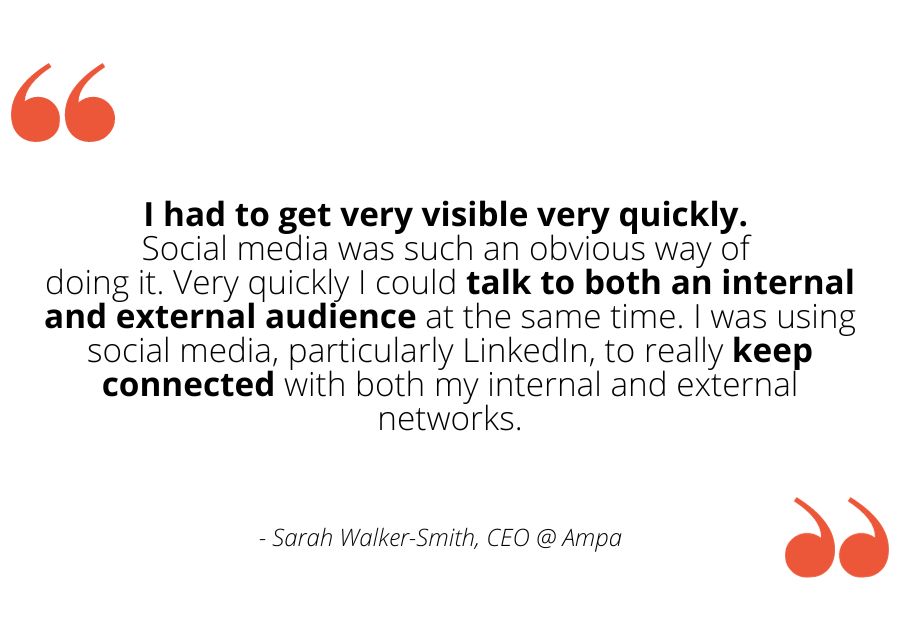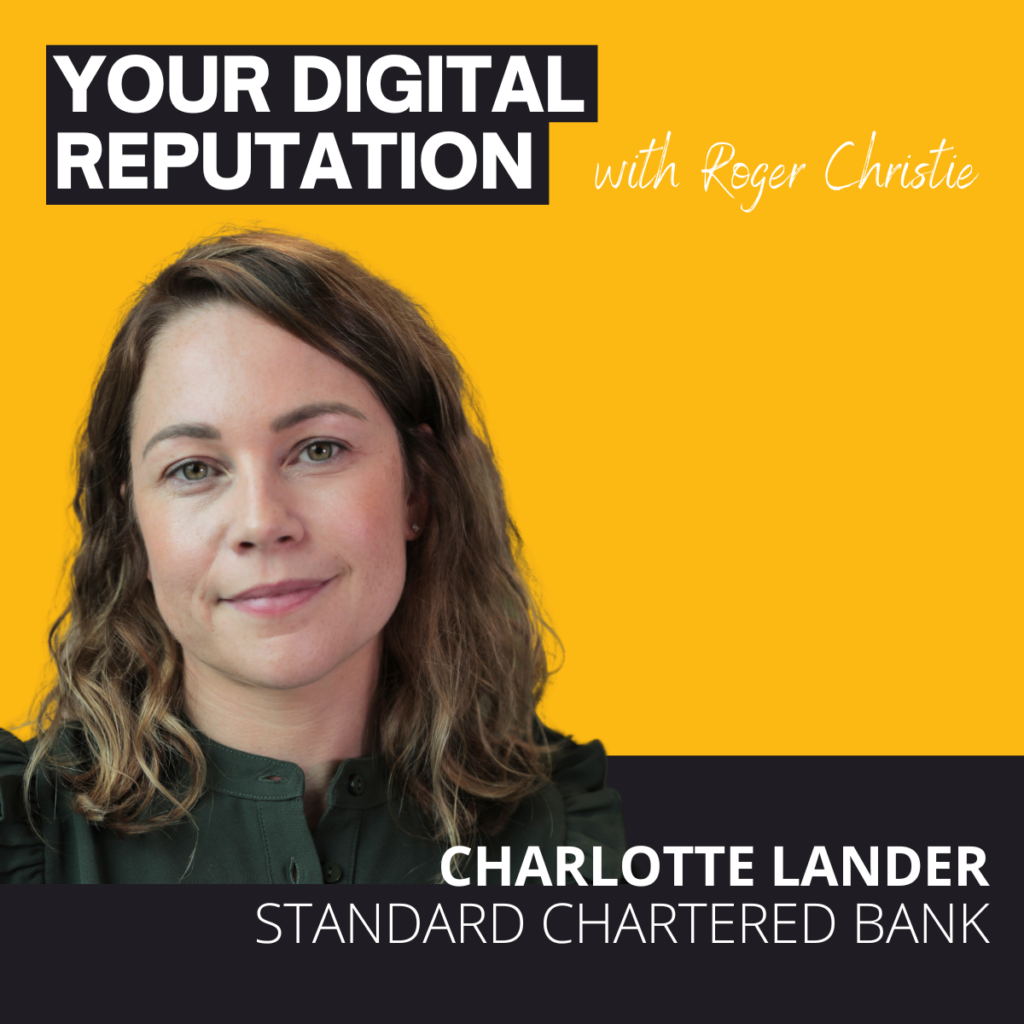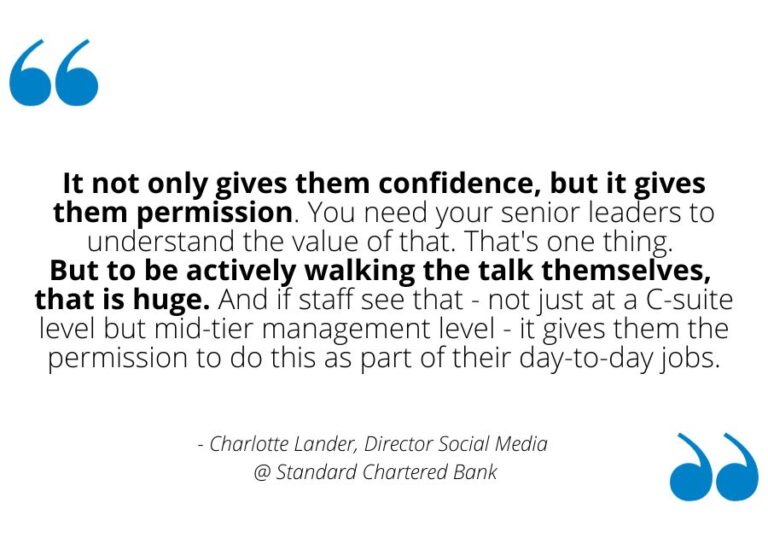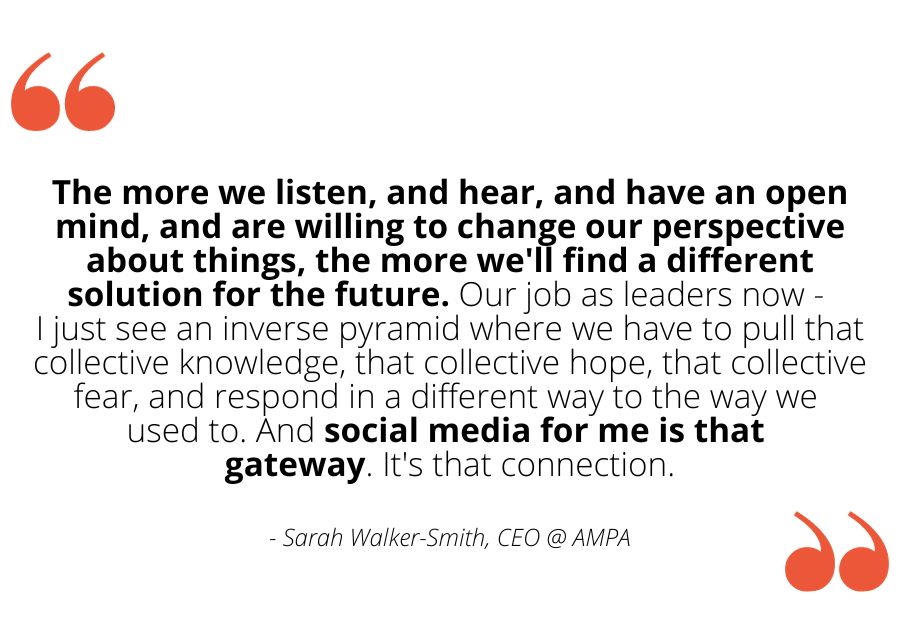
This Your Digital Reputation Practical Pod episode is a little different. For those who know me and Propel well, you’ll know we recently launched our 2023 Digital Reputation Report – which is a major piece of research looking into the ways senior leaders use LinkedIn. Last year we analysed 200 CEOs from our largest listed organisations, while this year we focused on our most senior public servants. Click the links above to download a copy of either report or drop me a note if you’re interested in all the data.
But my focus on the 2023 report meant we didn’t have our usual practical pod two weeks ago, so this is a sort of special double up episode brought to you by two very capable and accomplished figures in the world of leaders and LinkedIn. And both hailing from the UK. Yes – there was a clear, common and crucial thread that linked our two most recent guests on the Your Digital Reputation podcast, well beyond their shared location in the UK.
Charlotte Lander – Director of Social Media and former Global LinkedIn Lead at Standard Chartered Bank – was my guest a few weeks’ back discussing all things online employee advocacy. And then more recently, Sarah Walker-Smith – CEO of Ampa – the UK’s leading group of legal and professional services companies – and its largest law firm, Shakespeare Martineau – joined me to talk about why CEOs simply must have social in their toolkit.
Their common thread?
Leaders are the most essential ingredient for any organisation’s success on social media.
Whether that’s the more obvious aspect of using their own LinkedIn presence to reach, influence and understand key stakeholders as Sarah shared. Or the less overt – but, in fact more powerful – aspect of leaders setting the tone for their teams by showing up and amplifying good corporate culture, as Charlotte explained.
Whether for themselves and their own reputation, or their leadership peers and wider teams, or their broader stakeholder groups and their connection to the organisation – leaders set the tone online and leaders are the catalyst for a whole host of reputational benefits. They need to step up.
So what is this episode all about? I’ve taken five quotes on five key themes from my conversations with Sarah and Charlotte, and will explore each of them further while also providing practical tips on what you or your leaders can do to capitalise. Because until leaders are active, engaged and leading from the front, your organisation will continue to sit on the social media fringes with the connection, credibility and commercial benefits you’re after.
Let’s dive in.

VISIBILITY
Sarah’s talking about one of the more common use cases for leaders here – visibility. But it extends much further or deeper than just being seen.
Leaders and their comms teams have always sought the most effective and efficient ways to reach, influence and understand their key audiences. Historically, the best way to do that at scale was mainstream media. But what happens when media doesn’t want to tell your story, or the story they want to tell isn’t your preference…or the audience you’re trying to reach simply doesn’t read mainstream media?!
All three scenarios are a reality for leaders today. While mainstream media still plays a role, to have greater control over your narrative and to maintain connection with key audiences, you need to use the best channels for the job. In many cases today, that direct line is social media.
And, as Sarah describes in our conversation, it’s not just about reaching internal or external audiences. It’s both. Internal staff take greater notice when internal messages are shared externally. External audiences – like candidates – see the positive influence of corporate culture in those same messages, even if they weren’t the intended or primary audience. It’s two for the price of one for leaders, with free and potentially unlimited amplification on those messages online.
Social media’s power isn’t limited to the people leaders need to reach. It is searchable and accessible to anyone, anywhere at any time. The asynchronous nature of platforms like LinkedIn means any message can deliver multiple benefits to multiple audiences on multiple occasions. Sarah even shares a story in our chat about a tweet she’d written several years ago ultimately being the catalyst for her appointment to a Davos-style movement called Anthropy.
ACTION: So, if visibility is a need for you right now, what can you do?
1. Firstly, audit your current LinkedIn presence. How do you appear to your key audiences right now? And do you have the right, most important people in your network? There’s no point going to the effort of posting messages the wrong people – or, worse, no one – are going to see. By auditing and tidying up your profile, you’re giving yourself the best chance to influence digital first impressions. With your LinkedIn profile often being the first search result on Google, don’t waste the opportunity to make that first impression a positive one. I’ve just done almost 40 of these audits for leaders in the past month. If you need a hand, please drop me a note.
2. And the second element here – an important part of that audit and refinement process is defining your purpose. Yes, it’s without a doubt the most used term on this podcast, but if you’re yet to do your Purpose Pyramid you’re only limiting your impact. Click here or the image below to download our free template today and make time to set yourself up for success.
But visibility extends much deeper than just being seen, as Charlotte Lander explains in our next point.

PARTICIPATION
What Charlotte’s highlighting here is the benefit of active participation among leaders, and its flow on effects through the organisation. Propel’s recent Digital Reputation Report found that while 65% of the 100+ senior public servants we analysed had a LinkedIn profile, almost half of those hadn’t posted anything in the past six months. It’s like having a phone but never turning it on.
And, as it happens, the true power of platforms like LinkedIn is that leaders can take control of their own engagement efforts, and harness LinkedIn’s algorithm to ensure their messages reach the right people at the right time. Even just on a 1-1 basis, if that’s what matters.
So, if you’re keen to turn visibility into participation and reap the resulting benefits, what can you do? The simplest thing is intentional engagement.
Sarah and Charlotte talk to this. Visibility relies heavily on your own engagement efforts, and being seen by the right people means doing more than just broadcasting messages according to the comms schedule. It means investing time up front identifying your key audiences and then intentionally engaging with them to tell the LinkedIn algorithm who matters to you, and who you want seeing your content.
And if you’re wondering what the benefits are of this intentional engagement and how it can help your organisation, that’s where Sarah’s next point comes in.

TALENT
Sarah’s talking about the amazing talent benefits her own LinkedIn efforts have generated for the firm.
Why do leaders’ efforts matter here? And why can’t you just leave the brand or Company Page to do the work for you? Because the reality is only 3% of the content a LinkedIn user sees in their feed is Company Page content. 3%. It just doesn’t cut through.
That data from leading LinkedIn algorithm expert Richard van der Blom reinforces the importance of the human faces, voices and values leaders simply must share on LinkedIn.
It’s a point that screamed out at us from the data in our recent Digital Reputation Report, too. Purely human stories were 9x more effective at generating public engagement than purely work stories. 9x. When you consider those two statistics side by side, it’s clear to see why leaders must lead from the front on LinkedIn.
ACTION: So, what can you do on LinkedIn to attract and retain the right talent?
1. Get really clear on the values, behaviours and company culture you want to share online. You likely have plenty of industry competitors who do similar work to you – but what separates you and your organisation from the pack? Why are you different? And, importantly, what stories and examples bring that point of difference to life?
2. A tip here – these won’t all be your stories, obviously. The views and voices of your staff matter, too. So, for the purposes of talent attraction and retention, it’s vital you have many more than just the one leader voice on LinkedIn. Review your social media policy and education processes for staff – are you empowering them to follow suit online and share the everyday stories that will resonate with their networks and candidates. Unearthing this army of authentic voices is the difference between having a visible leader and a talent magnet machine online.
And that leads neatly into our next theme from Charlotte.

PERMISSION
I touched on this in the last theme when I said ‘It’s vital you have many more than just the one leader voice on LinkedIn.’ Because every workplace is diverse. And every organisation’s stakeholders are diverse. Your customers, your candidates – they need to see themselves in the voices and stories of your people in order to engage fully. Representation matters. And, therefore, permission is key.
Charlotte used another great turn of phrase in our conversation where she said “You must empower your colleagues, not use them as part of the program… They’re not another marketing mouthpiece.” This is all about permission, not coercion.
And – as Charlotte listed – when leaders grant that permission through their own actions, here are some of the benefits the organisation at large stands to access:
Organisations with advocacy programs enjoy:
– 79% more visibility;
– a 65% increase in brand recall; and
– a 53% increase in brand engagement.
And they’re 58% more likely to attract talent according to LinkedIn. Organisations with advocacy programs are 20% more likely to retain top talent according to Job Fight. 77% of people say that their purchasing decision is based on hearing from somebody they trust according to Statusbrew. And organisations get seven times more leads generated from employee networks vs. the brand, according to IBM.
ACTION: These are some serious numbers. So, if you’d like to benefit in these ways, there are some very practical things you can do:
- Check your policies! I’ve said it before and I’ll say it again – your social media policies or guidelines are an important reference point for staff, particularly as leaders can often have slightly different rules applied given their authority. Check that your policies empower and give permission to teams, vs. discouraging them.
- And one final thing – don’t just set a policy and an example through your own actions online, and assume everyone will dive in after you. Engage your comms and people and culture teams to run regular capability building and Q&A sessions around social media use. Build familiarity and confidence with teams. Even consider running pilot programs with smaller groups every other month. Showing people it’s not just ok but encouraged to participate online makes an enormous difference.
That was quite a compelling argument from Charlotte. But is there still more organisations can gain when their leaders are visible, active and empower others online?

INNOVATION
The final point from Sarah here relates to one of the core benefits that leaders and their organisations discover when they empower their people to get active online. Innovation.
No one person or team has the knowledge and skills required to solve the wicked, complex challenges the world faces today – as Martin Stewart-Weeks (Episode #14) beautifully frames them – we must look outward and embrace connection and collaboration to stay ahead.
That’s what Sarah is talking to here. Tapping into the global knowledge and relationships bank that is social media to find better ways of doing things, and challenging the ways of old. It’s what Elliott Franks in the Queensland Government referenced (Episode #33) when he talked about reaching across the digital aisle to form cross-sector relationships and knowledge sharing that would enrich his own teams’ expertise. Social media is that gateway, and any organisation missing out on that knowledge base simply cannot keep up.
But, as you’ve heard through this podcast, it starts with leaders being visible and setting the standard, and it requires staff – too – to get active. But once you have those foundations in place, you have an incredibly powerful innovation engine that will serve your organisation well for years to come. Social media can be the infrastructure for innovation.
ACTION: So, what can you do if innovation is a priority for you?
- Again, review any social media policies and training to ensure teams are empowered to get online and active. But a way to build on that and other foundations you’ve now set – bake social media training and literacy into your onboarding processes. And I don’t mean the standard “Thrilled to be joining!” LinkedIn post that we all know.
Don’t get me wrong – those posts are actually really valuable when done well. But what I mean here is baking capability into the onboarding process. That means staff seeing how you use social media, why, and what it means for them. It means having a community of practice that is less about the technical craft of representing the brand online and more about how platforms like LinkedIn are an enabler for sales, recruitment, product and reputation outcomes. Sharing and learning from real-life examples across the organisation from day one. If this is the one thing you do after building on your foundations, a new level of innovation will be just around the corner.
There are five invaluable tips and five invaluable outcomes any leader can access by taking a more intentional approach to their LinkedIn or social media efforts. Plenty of wisdom from the very wise Sarah Walker-Smith at Ampa, and Charlotte Lander at Standard Chartered. Remember to go back and check out their full episodes – #37 and #38 – to learn from all the wonderful advice, experience and data they shared.
I hope this has given you plenty of food for thought, and – as always – please do drop me a note via LinkedIn if you have any questions or need guidance on where to next on LinkedIn.
37. CHARLOTTE LANDER | How to build the best online employee advocacy?
Feel free to drop Roger Christie a note with any thoughts from this conversation. If you want more on all things digital reputation, be sure to subscribe below to the Your Digital Reputation newsletter. Join hundreds of subscribers from around the world already signed up!






